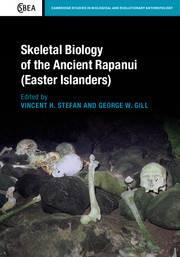Description
Skeletal Biology of the Ancient Rapanui (Easter Islanders)
Cambridge Studies in Biological and Evolutionary Anthropology Series
Coordinators: Stefan Vincent H., Gill George W.
A succinct volume presenting current views of Rapanui prehistory, utilising biological evidence to modify existing archaeological and cultural anthropological preconceptions.
Language: English
Subject for Skeletal Biology of the Ancient Rapanui (Easter Islanders):
Publication date: 01-2016
347 p. · 17.9x25.2 cm · Hardback
347 p. · 17.9x25.2 cm · Hardback
Description
/li>Contents
/li>Biography
/li>
Disseminating what is currently known about the skeletal biology of the ancient Rapanui and placing it within the wider context of Polynesian skeletal variation, this volume is the culmination of over thirty years of research into the remotely inhabited Easter Island. Compiling osteological data deriving from Rapanui skeletal remains into one succinct analysis, this book demonstrates how the application of modern skeletal biology research techniques can effectively be employed to address questions of human population origins and microevolution. Craniometrics and DNA analysis are used to provide indications as to Rapanui ancestral lineage. Evidence is presented in a user-friendly manner to allow researchers and graduates to critically analyse the current knowledge of prehistoric Rapanui skeletal variation. An important resource providing valuable evidence from human biology that modifies earlier archaeological and cultural anthropological views, this book will stimulate further research into the Rapanui.
List of contributors; Acknowledgements; 1. Introduction: research overview George W. Gill; 2. Review of Polynesian and Pacific skeletal biology Michael Pietrusewsky and Michele Toomay Douglas; 3. Chronology and Easter Island prehistory Carl P. Lipo and Terry L. Hunt; 4. A descriptive skeletal biology analysis of the ancient Easter Island population George W. Gill and Vincent H. Stefan; 5. Craniometric variation of the prehistoric Polynesians and Rapanui Vincent H. Stefan; 6. Rapanui nonmetric cranial traits Patrick M. Chapman; 7. Intra-island discrete cranial trait variation Thomas Furgeson and George W. Gill; 8. Continuous nonmetric characteristics of the early Rapanui George W. Gill; 9. Rapanui dental morphology Vincent H. Stefan and Randy Rozen; 10. Pelvic variability and sexual dimorphism in prehistoric Rapanui Amber Harrison and Nathan K. Harper; 11. Genetic affinities of the Rapanui Erika Hagelberg; 12. Archaeogenetics and paleodemographic estimation of founding populations: features of residential geography on Rapanui John V. Dudgeon, Amy S. Commendador and Monica Tromp; 13. Evidence for injuries and violent death Douglas W. Owsley, Kathryn G. Barca, Vicki E. Simon and George W. Gill; 14. Demographic analysis of modified crania from Rapanui Douglas W. Owsley, Vicki E. Simon, Kathryn G. Barca, Jo Anne Van Tilburg and Deidre Whitmore; 15. East Polynesian and Paleoindian parallels and contrasts in skeletal morphology George W. Gill; 16. Rapanui origins, relationships and warfare: a summary in theoretical context George W. Gill and Vincent H. Stefan; References; Index.
Vincent H. Stefan is a Professor in the Department of Anthropology at Herbert H. Lehman College and the Graduate School, City University of New York, as well as a faculty member of the New York Consortium in Evolutionary Primatology. His research centres upon the documentation and analysis of contemporary and prehistoric skeletal variation, as well as forensic skeletal analysis and identification.
George W. Gill is a Distinguished Professor Emeritus of Anthropology at the University of Wyoming where he taught bioanthropology for forty years. He is a former Chair of Anthropology and Director of the University of Wyoming Anthropology Museum. His ongoing research interests include American and Polynesian skeletal biology and bioarchaeology, Paleoindian osteology, and forensic skeletal analysis and identification.
George W. Gill is a Distinguished Professor Emeritus of Anthropology at the University of Wyoming where he taught bioanthropology for forty years. He is a former Chair of Anthropology and Director of the University of Wyoming Anthropology Museum. His ongoing research interests include American and Polynesian skeletal biology and bioarchaeology, Paleoindian osteology, and forensic skeletal analysis and identification.
© 2024 LAVOISIER S.A.S.

